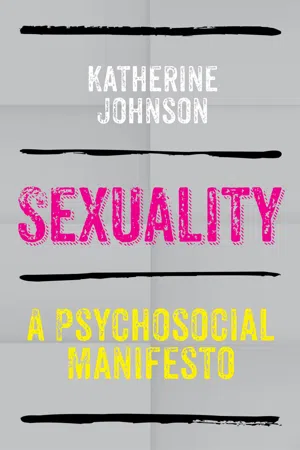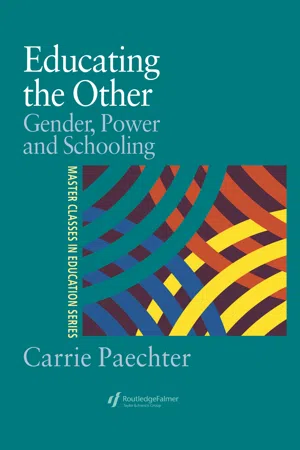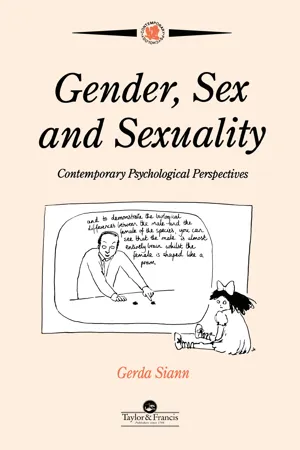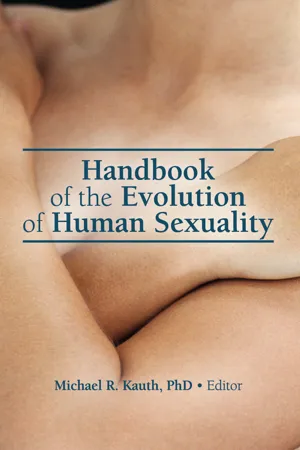Psychology
Gender and Sexuality
Gender refers to the social and cultural roles, behaviors, and expectations associated with being male or female, while sexuality encompasses a person's sexual orientation, desires, and behaviors. In psychology, the study of gender and sexuality explores how these aspects of identity are shaped by biological, psychological, and social factors, and how they influence individuals' thoughts, emotions, and behaviors.
Written by Perlego with AI-assistance
Related key terms
9 Key excerpts on "Gender and Sexuality"
- eBook - ePub
- Justin J. Lehmiller(Author)
- 2017(Publication Date)
- Wiley-Blackwell(Publisher)
Although many people use these words interchangeably, it is important to recognize that they have very different meanings and refer to separate aspects of the self. Sex is the term we use to categorize whether someone is biologically male, female, or intersex. There are three different dimensions of sex we will discuss momentarily: chromosomes, gonads, and hormones. In contrast, gender is a psychosocial term that encapsulates all of the psychological, cultural, and social characteristics we think of as belonging to men, women, and other gender groups. Thus, gender refers to our set of expectations about what makes someone masculine or feminine. Related to the concept of gender are three other important terms that will come up repeatedly throughout this chapter and later in the book: gender identity, gender roles, and gender stereotypes. Gender identity refers to an individual's own psychological perception of being male, female, neither, both, or something in between. Although people's gender identity is usually consistent with their biological sex, this is not always the case. Thus, someone with a biological sex of male could identify as female and vice versa. This is a form of transgenderism, a concept we will discuss at length later in this chapter. Figure 5.1 Chaz Bono is a female-to-male transsexual who received international media scrutiny upon announcing that he was transitioning into a man. Chaz and others like him are an important reminder than not everyone fits neatly into a two-category gender system. ©s_bukley, 2013. Used under license from Shutterstock.com. Gender roles refer to a set of cultural norms or rules that dictate how people of a specific sex “should” behave - eBook - ePub
Sexuality
A Psychosocial Manifesto
- Katherine Johnson(Author)
- 2015(Publication Date)
- Polity(Publisher)
Despite Helen Merrell Lynd’s warning polarization between psychological and socio-historical approaches has been an all too familiar feature of late twentieth-century thought, particularly in the field of sexuality. In reviewing prominent theories and debates it is reasonable to claim that this polarization constitutes a ‘kind of conceptual impasse’, found in many accounts influenced by either Marx or Freud, or latterly Freud and Foucault, whose vital work sets the scene for contemporary understandings of sexuality within academia and everyday life. This book explores the polarization between psychological and socio-historical accounts that are documented well in sexuality studies and somewhat ambitiously proposes an alternative, a psychosocial manifesto that seeks to stitch and mend the polarization. Yet, as Sedgwick states, trying to remedy, or even articulate the impasse is not without its own problems. Specifically, in trying to articulate accounts of sexuality without recourse to a polarization between psychology and historicism invites us to engage with the ‘psychosocial’, but inevitably within this articulation it is difficult not to fall back on the mechanisms that constitute the split.The term sexuality can refer to a set of practices or behaviours, a range of feelings or affects, or as a way of categorizing people on the basis of their sexual orientation, sexual identity or political allegiances. The plural, sexualities, is utilized to acknowledge the multiple meanings of sexuality and to recognize that an understanding of contemporary sexuality needs to engage with a proliferation of identity categories, sexual practices, subjectivities, desires and relationship formations, including for example queer or trans alongside more familiar categories such as heterosexual, lesbian, gay and bisexual. This book explores the way in which the term is conceptualized in an array of psychological and social debate, such as neuroanatomy, adolescent development, sexual health, youth suicide, identity politics or gay marriage, and provides access to a range of theoretical perspectives that seek to explain how sexuality is developed, constructed, queered, embodied and transformed.Since the late 1800s, sexologists and psychologists have tended to promote the view that sexuality has its origins in biological processes underpinned by hormones, drives, and more recently, genetics. In contrast, historians and sociologists point to the social field as the defining force that shapes the meanings given to sexuality and sexual experience. This observation provides the starting point for investigating how polarization produces different forms of knowledge and the impact these have on how sexuality can be experienced in personal and political contexts. Such distinctions are familiar within social science accounts of sexuality, but they are also apparent within the humanities and queer studies. For example, Michael Warner (1993) expressed a similar warning to Lynd in the seminal text Fear of a Queer Planet - eBook - ePub
- Meg John Barker(Author)
- 2018(Publication Date)
- Routledge(Publisher)
2 Sex and Sexuality We tend to see sex as a fundamental aspect of who we are as human beings. A person’s sexuality is regarded as a vital aspect of their identity: a key piece of demographic information to measure alongside their gender, age, and ethnicity. We think it’s important for people to be open about their sexuality: to ‘come out’ about who they are. And our knowledge or assumptions about a person’s sexuality affects our expectations about what they’ll be like as a person. What is Sexuality? But what do we mean by sexuality? Think for a moment about what your answer would be if you were asked for your sexuality on a form or questionnaire. Before we get into this chapter let’s pull out some of the common cultural assumptions about sexuality. As we do so, you can start to think about whether or not they reflect your understanding and experience of sexuality. The terms ‘sexuality’, ‘sexual identity’, and ‘sexual orientation’ tend to be used fairly interchangeably, and the latter two terms help to unpack what we generally mean by sexuality. It’s a key feature of a person’s identity which is defined by who they orient towards sexually: in other words, who they are sexually attracted to. As an identity, sexuality is generally assumed to be an essential aspect of who we are: part of our fundamental essence as a human being. As such, it’s generally assumed to be fixed and unchanging over the course of a life, which is partly why it makes sense to ask it as a piece of demographic information. It’s often assumed to be a natural or biological feature of who we are: you were born this way and you’ll stay this way. As an orientation, sexuality is all about who we’re sexually attracted to in terms of our sex and theirs. Are we attracted to the ‘opposite sex’ or the ‘same sex’? Are we heterosexual or homosexual? There’s generally an assumption that people are heterosexual unless they say otherwise. Coming out is associated with gay rather than straight people - eBook - ePub
Educating the Other
Gender, Power and Schooling
- Dr Carrie Paechter, Carrie Paechter(Authors)
- 2002(Publication Date)
- Routledge(Publisher)
For the sake of clarity, I want to start by distinguishing a number of terms, and explaining how I intend to use them. The meanings of these terms are all more or less a matter of dispute in the literature regarding sex and gender, and can be used in conflicting ways by different authors. Furthermore, some of them are themselves constructed in such a way as to support inequality and will, because of this, be deconstructed later in the chapter. Accordingly, these are only fairly general and approximate definitions, constructed for the purpose of making distinctions between the different kinds of thing I am going to be talking about.By sex I refer to matters of biology. Although, as I shall explain later, even how we understand matters of biology is culturally constructed, a person’s sex is usually taken to be a matter of biological fact. It is often seen as a given which is prior to the construction of an individual’s gender, a site upon which particular gender characteristics are superimposed (Nicholson, 1994).Gender assignment (Kessler and McKenna, 1978) is usually a once-andforall event based on physical characteristics at birth. A newborn baby is assigned a gender after physical examination. Usually, but not always, this assignment is consonant with (some definition of) biological sex.Gender identity refers to a person’s own feelings about whether they are male, female, both or neither. Such an identity may be different to their assigned gender. It is the gender they attribute to themselves, and is usually established by age 3. The only way to establish someone’s gender identity is to ask them; gender identity is a private experience (Kessler and McKenna, 1978; Money and Ehrhardt, 1972).Finally, gender role refers to a set of behavioural prescriptions or proscriptions for individuals who have a particular assigned gender. These will vary between cultures (Kessler and McKenna, 1978; Nicholson, 1994; Money and Ehrhardt, 1972; Whitehead, 1981). In order to distinguish matters of gender role from those of gender assignment, gender identity and biological sex, I shall generally talk of masculinity and femininity in this context. - eBook - ePub
Gender, Sex and Sexuality
Contemporary Psychological Perspectives
- Gerda Siann(Author)
- 2013(Publication Date)
- Taylor & Francis(Publisher)
With remarkably few exceptions people identify themselves quickly and easily as either male or female and consequently filling in the category labelled sex on a questionnaire, or ticking a box labelled male or female rarely presents problems. As chapter 3 will indicate, this apparent unambiguity is sometimes illusory and in a small minority of cases sexual assignation is not straightforward. However, for the time being, we will make the assumption that we are all born as either male or female and we will go on to look at the manner in which that sexual identification interacts with another identification - that of gender.For some time it has been customary for social scientists to make the following distinction between sex and gender. Sex is defined as the biological differences between males and females and gender is the manner in which culture defines and constrains these differences; not only differences in the manner in which women, in general, live their lives compared to men in general, but also differences in the manner in which individuals view both themselves and others, in terms of the female/male dichotomy. Obviously then, gender and the labels associated with it, primarily those two descriptors, ‘feminine’ and ‘masculine’, are neither fixed nor immutable depending as they do on cultural constructions.This is not to imply that the sexual distinction itself is absolute and immune from subjective biases. For, as we shall see in chapter 3, even biologists and endocrinologists (Lorber and Farrell, 1991) have discovered that not everyone fits as neatly into the categories male and female as once was assumed. Rather it is to make the point that if the concept of sex is no longer seen as absolute because distinctions about it are made by people living in particular cultures at particular times, how much less absolute must be distinctions concerned with gender.In this chapter we will look at three major ways in which gender as a category system can be thought of as operating and then we will consider the cultural context in which sexuality is viewed. Before starting to look at gender as a category system, however, let us place the discussion within the context of the basic inequality that has until recently dominated established thinking about gender. This inequality has reflected the opinion of men rather than women and the reason for this inequality lies in the fact that, until very recently, in most societies power and status have been very unequally apportioned between the sexes. Many of these inequalities are on the wane but others have remained obstinately persistent. Looking specifically for the moment at the UK, it is clear that the battle for female equality is not over. For while women have won some spectacular victories, such as for example the right to be ordained as priests in the Church of England, progress at other more mundane but particularly vital levels has been slow, laborious and in some cases static. Women continue to be massively under-represented at all levels of government (O’Reilly, 1992); continue to earn less than men both in general and, in many instances, compared to men in similar positions (Equal Opportunities Commission, 1992); continue to experience bias in promotion to management (Institute of Management, 1992) and at times continue to see their experience of sexual and physical abuse trivialized and minimized (Scully, 1990). - eBook - ePub
Human Sexuality
Biological, Psychological, and Cultural Perspectives
- Anne Bolin, Patricia Whelehan, Muriel Vernon, Katja Antoine(Authors)
- 2021(Publication Date)
- Routledge(Publisher)
15 Sex, Sexuality, and GenderChapter Overview
- 1 Examines gender roles relative to concepts of psychological masculinity and femininity.
- 2 Incorporates an anthropological discussion of gender variance including the transgender community in the United States and other industrialized societies and cross-cultural gender variance.
Gender Identities and Gender Roles
Although concepts of gender identity (knowing that you are male, female, or intersex) (Williams, 1986) and gender role (adopting culturally defined male and female behavior) are probably widespread cross-culturally, their expression is highly culture-specific. Chapters 1 and 2 discuss the symbolism of maleness and femaleness and the diversity of gender role behavior among cultures (e.g., Margaret Mead’s classic work is one body of recently challenged research on this topic: Mead, 1949, 1961 [1928], 1963 [1935]). We also know from the literature that culture change can impact gender roles cross-culturally (Lurie, 1973; Radin, 1926; Sharp, 1981). However, the extensive amount of energy vested in examining and trying to understand gender role behavior through the life cycle in the late twentieth and early twenty-first centuries is largely a function of middle-class industrialized and, specifically, US culture.In this chapter, some of the current issues in male-female relationships, and gender roles in mainstream US culture, as well as subcultures within the larger society, are addressed. As part of the “Sexual Revolution” of the 1960s, a tremendous amount of time, energy, and attention was directed toward defining and elaborating concepts of gender role and gender identity, masculinity and femininity.The 1960s and 1970s alleged Sexual Revolution served as a sexual, social, economic, and political statement against the perceived negative aspects of traditional gender role behaviors and expectations. In its most extreme form, anything defined as “traditional” was seen as negative. Some questions arose as to whether a sexual revolution occurred (radical or root change, qualitative, wide-scale, behavioral and attitudinal changes) (Ehrenreich, Hess, and Jacobs, 1986; Elshtain, 1989; Farrell, 1986; Goldberg, 1979, 1984), or whether a reform movement occurred (a rebellion in which behaviors became more overt and widespread, and attitudes remained relatively constant) (cf. Hendrick and Hendrick, 1987; McCabe, 1987). Since the 1960s, sexual behaviors have become more visible, open, and discussed in the culture. (Note the advent of the Oprah and Dr. Phil television shows discussing sex issues and the portrayal of sex on television in sitcoms and dramas.) The Sexual Revolution introduced the concepts of liberated and androgynous gender role - eBook - ePub
Sex In Question
French Feminism
- Lisa Adkins, Diana Leonard(Authors)
- 2004(Publication Date)
- Taylor & Francis(Publisher)
This led me to distinguish three main ways of thinking about the relationship between sex and gender. In each we can distinguish simultaneously:The play of congruence and incongruence (between norm and marginality, and between sex and gender) was, thus, the focal point of the analysis—alongside the play of asymmetry and symmetry between the sexes in some of the phenomena studied.- a problematic of personal identity in relation to the sexed body and sexuality, but also in relation to the status of the person in the social organization of ‘sex’;
- a strategy of relations between the sexes;
- an understanding of the relationship between biological sex and social sex (or between sex and gender); and
- a definition of the relationship between hetero-and homosexuality, in other words, the relationship between sex, Gender and Sexuality.
- Mode I : ‘sexual’ identity, based on an individualistic consciousness of sex; where sex and gender are homologically connected: here gender translates sex.
- Mode II : ‘sexed’ identity, based on a sex group consciousness; where sex and gender are analogically connected: here gender symbolises sex (and, conversely, sex symbolises gender).
- Mode III : ‘sex-class’ identity, based on a sex class consciousness; where sex and gender are socio-logically connected: here gender constructs sex.
- Each of these three types of ‘logic’ can be an expression of either the norms of a society or a particular group, or it can derive from marginal or ‘oppositional’ individuals or groups.
- eBook - ePub
Sex, Sexuality and Therapeutic Practice
A Manual for Therapists and Trainers
- Catherine Butler, Amanda O'Donovan, Elizabeth Shaw(Authors)
- 2009(Publication Date)
- Routledge(Publisher)
Across all stages of life, sexuality and sex shape our experiences of ourselves, our bodies, our relationships and our desire and need for intimacy and love. Establishing a sexual identity, finding meaningful and satisfying relationships and integrating sex and love are the tasks of a lifetime. Sexuality across the lifespan is defined by constantly evolving narratives around how we think about sex, sexual feelings, sensual touch, sexual risk-taking and well-being. A detailed understanding of sex and sexuality encompasses neurobiology, hormonal influences, developmental psychology, attachment, personality and rich social and cultural contexts. Current theories and knowledge are also powerfully shaped by limits and prohibitions on what areas of sex and sexuality it has been permissible to research. Remaining curious about our own, and our clients’, stories about sex and sexuality can help us to develop rich and compassionate understandings of these complex and changing narratives and facilitate ways to talk about sex.FURTHER RESOURCES
Development of sexuality
Hill, C. (2008). Human sexuality: Personality and social perspectives . Sage Publications. http://www.sagepub.com/hillhsstudy/ for online resources.Women’s Aid. National domestic violence charity has free resources for teaching children and young people about healthy relationships, respect and what to do if you are experiencing abuse. http://www.womensaid.org.ukPike, L.B. (2009). Sexuality and Your Child: For Children Ages 3 to 7 . Missouri, US: Department of Human Development & Family Studies, Uni Missouri. http://extension.missouri.edu/explorepdf/hesguide/humanrel/gh6002.pdfNo Outsiders Project—booklet and resources for use in primary schools and early years settings to support teachers and children to address lesbian, gay, bisexual and transgender equality. http://www.nooutsiders.sunderland.ac.ukChildren and young people
Brook. National voluntary sector provider of free and confidential sexual health advice and services specifically for young people under 25. Advice for professionals on sex and the law. http://www.brook.org.ukLondon Safeguarding Children Board. Service support for children professionals and local communities in safeguarding children. http://www.londonscb.gov.uk - eBook - ePub
- Michael R. Kauth(Author)
- 2013(Publication Date)
- Routledge(Publisher)
behaviors of men are differentially related to sexual orientation, but only insomuch as the pool of potential mates for gay men consists of other men and their sociosexual attitudes, and is not impacted by the relatively restricted attitudes of women. The sexual psychology of women across cultures also shows a distinctive, recurring pattern. In general, heterosexual women and lesbians share many of the same features (e.g., restricted sociosexuality), whereas bisexual women across all cultures tend to be more unrestricted in terms of both attitudes and behaviors.Issues for Further Consideration
In the ISDP, sexual orientation was primarily measured with a simple categorical item in which participants circled one of three choices: heterosexual, homosexual, or bisexual. The use of simple self-identification for assessing sexual orientation is problematic (Gonsiorek & Weinrich, 1995; Haslam, 1997). In the current study, scores on self-identification categories did converge with the bipolar measure of sexual orientation from the Sexy Seven measure (Schmitt & Buss, 2000). Still, individual differences in sexual orientation cannot be fully measured by unidimensional characterizations or trichotomous constructs, although sexual orientation is most commonly measured in this way (Chung & Katayama, 1996). Moreover, same-sex sexual orientations are not the same as same-sex sexual behaviors (Muscarella, 1999), and gays and lesbians may define “sexual behavior” in different ways than do heterosexuals (Carpenter, 2001; Vohs, Catanese, & Baumeister, 2004), particularly across cultures. Indeed, self-labeling as a homosexual or bisexual carries with it extreme social costs in many non-Western cultures, something not fully accounted for in the current study. In the future, measurements of the full spectrum of sexual orientations and specific sexual behaviors are needed to more formally evaluate evolutionary perspectives on human mating.
Learn about this page
Index pages curate the most relevant extracts from our library of academic textbooks. They’ve been created using an in-house natural language model (NLM), each adding context and meaning to key research topics.








